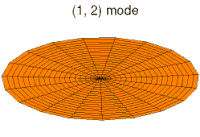
Photo from wikipedia
Abstract Mode shapes have been extensively used to identify structural damage. This paper presents a new non-model-based method that uses principal, mean and Gaussian curvature mode shapes (CMSs) to identify… Click to show full abstract
Abstract Mode shapes have been extensively used to identify structural damage. This paper presents a new non-model-based method that uses principal, mean and Gaussian curvature mode shapes (CMSs) to identify damage in plates; the method is applicable to mode shapes associated with low and high elastic modes on dense and coarse measurement grids and robust against measurement noise. A multi-scale discrete differential-geometry scheme is proposed to calculate principal, mean and Gaussian CMSs associated with a mode shape of a plate, which can alleviate adverse effects of measurement noise on calculating the CMSs. Principal, mean and Gaussian CMSs of a damaged plate and those of an undamaged one are used to yield four curvature damage indices (CDIs), including Maximum-CDIs, Minimum-CDIs, Mean-CDIs and Gaussian-CDIs. Damage can be identified near regions with consistently higher values of the CDIs. It is shown that a mode shape of an undamaged plate can be well approximated using a polynomial of a properly determined order that fits a mode shape of a damaged one, provided that the undamaged plate has a smooth geometry and is made of material that has no stiffness and mass discontinuities. Fitting and convergence indices are introduced to quantify the level of approximation of a mode shape from a polynomial fit to that of a damaged plate and to determine the proper order of the polynomial fit, respectively. A weight function is applied to the proposed CDIs to alleviate adverse effects of measurement noise on the CDIs and manifest existence of damage in the CDIs. A mode shape of an aluminum plate with damage in the form of a machined thickness reduction area was measured to experimentally investigate effectiveness of the proposed CDIs in damage identification; the damage on the plate was successfully identified. The experimental damage identification results were numerically verified by applying the proposed method to the mode shape associated with the same mode as that of the measured one from a finite element model of the damaged plate.
Journal Title: Journal of Sound and Vibration
Year Published: 2017
Link to full text (if available)
Share on Social Media: Sign Up to like & get
recommendations!